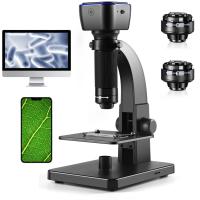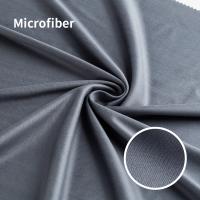Why Are Cells Stained When Using A Microscope ?
Cells are stained when using a microscope to enhance their visibility and contrast. Staining involves the application of dyes or stains to the cells, which selectively bind to different cellular components, such as proteins, DNA, or cell membranes. This process helps to highlight specific structures or organelles within the cells, making them easier to observe and study under the microscope. Staining can also reveal important information about the cellular structure, function, and organization, aiding in the identification and characterization of different cell types or pathological changes.
1、 Cell Structure: Visualizing cellular components through staining techniques.
Cells are stained when using a microscope for several reasons. One of the main reasons is to enhance the visibility of cellular components and structures. The use of stains allows researchers and scientists to visualize and study the intricate details of cells that would otherwise be difficult to observe under a microscope. Staining techniques provide contrast and highlight specific cellular components, making them easier to identify and analyze.
Staining also helps in distinguishing different types of cells and their structures. By using specific stains, scientists can differentiate between different cell types, such as epithelial cells, muscle cells, or nerve cells. This differentiation is crucial for understanding the organization and function of tissues and organs.
Moreover, staining techniques can reveal important information about the health and functionality of cells. For example, certain stains can be used to identify specific cellular structures or molecules that are indicative of disease or abnormal cellular processes. This can aid in the diagnosis and treatment of various medical conditions.
In recent years, advancements in staining techniques have allowed for more precise and targeted visualization of cellular components. Fluorescent dyes and probes have revolutionized cell staining, enabling researchers to label specific molecules or structures with high specificity and sensitivity. This has opened up new avenues for studying cellular processes and interactions in real-time.
In conclusion, staining cells when using a microscope is essential for visualizing cellular components and structures, distinguishing different cell types, and understanding cellular functionality. The latest advancements in staining techniques have further enhanced our ability to study cells and have contributed to significant advancements in various fields, including cell biology, medicine, and biotechnology.

2、 Contrast Enhancement: Increasing visibility of cells for microscopic examination.
Cells are stained when using a microscope primarily for contrast enhancement, which increases the visibility of cells for microscopic examination. The staining process involves the application of dyes or stains to the cells, which selectively bind to specific cellular components, making them more easily distinguishable under the microscope.
The main reason for staining cells is to overcome the inherent limitations of light microscopy, which relies on the interaction of light with the cellular components to produce an image. Unstained cells often lack sufficient contrast, as most cellular structures are transparent and have similar refractive indices. This lack of contrast makes it difficult to differentiate between different cellular components and observe their morphology and organization accurately.
By staining cells, the dyes or stains introduce color or fluorescence to specific cellular structures, such as the nucleus, cytoplasm, or specific organelles. This color contrast allows for better visualization and differentiation of cellular components, enabling researchers to study cell structure, function, and behavior more effectively.
Moreover, staining can also provide additional information about the cells, such as their viability, metabolic activity, or specific molecular markers. For example, certain stains can indicate the presence of specific proteins, DNA, or RNA within the cells, aiding in the identification and characterization of different cell types or pathological conditions.
In recent years, advancements in staining techniques have allowed for more specific and targeted staining of cells. Fluorescent dyes and probes, for instance, can be used to label specific molecules or structures within the cells, enabling researchers to track their movement and interactions in real-time. This has revolutionized the field of cell biology and has led to significant advancements in our understanding of cellular processes and diseases.
In conclusion, staining cells when using a microscope is crucial for contrast enhancement, allowing for better visualization and differentiation of cellular components. It not only improves the visibility of cells but also provides valuable information about their structure, function, and molecular characteristics. With the continuous development of staining techniques, researchers can delve deeper into the intricate world of cells and unravel the mysteries of life at a microscopic level.

3、 Dye Selection: Choosing appropriate stains to highlight specific cellular structures.
Cells are stained when using a microscope for several reasons, with the primary purpose being to enhance the visibility of cellular structures. Staining allows researchers and scientists to observe and study cells more effectively by providing contrast and highlighting specific components of interest.
Dye selection plays a crucial role in the staining process. Different dyes have specific affinities for different cellular structures, allowing researchers to selectively stain and visualize specific components. For example, nuclear stains such as DAPI or Hoechst bind to DNA, highlighting the cell nucleus. Fluorescent dyes like GFP or RFP can be used to label specific proteins or organelles, enabling the visualization of their distribution and dynamics within the cell.
Staining also aids in distinguishing between different cell types or identifying abnormal cells. By using specific dyes, researchers can differentiate between different cell populations based on their staining patterns. This is particularly useful in fields like pathology, where the identification of abnormal cells is crucial for diagnosing diseases.
Moreover, staining can provide valuable information about cellular processes and functions. For instance, staining with dyes that indicate cell viability or apoptosis can help determine the health status of cells. Staining techniques can also be used to study cellular processes such as cell division, migration, or differentiation by visualizing specific markers or structures involved in these processes.
In recent years, advancements in staining techniques have allowed for more precise and specific visualization of cellular structures. Techniques like immunofluorescence staining, which uses antibodies to target specific proteins, have revolutionized the field by enabling the visualization of specific molecules within cells. Additionally, the development of live-cell staining techniques has allowed researchers to observe dynamic cellular processes in real-time.
In conclusion, cells are stained when using a microscope to enhance visibility and highlight specific cellular structures. Dye selection is crucial in this process, as it allows for the selective staining of specific components of interest. Staining techniques have evolved over time, providing researchers with valuable insights into cellular processes and functions.

4、 Fixation Methods: Preparing cells for staining by preserving their morphology.
Cells are stained when using a microscope primarily to enhance their visibility and to study their structure and function. Staining allows researchers to observe and differentiate various cellular components, such as the nucleus, cytoplasm, and organelles, which would otherwise be difficult to distinguish under normal microscopy.
One of the main reasons for staining cells is to preserve their morphology through fixation methods. Fixation involves treating the cells with chemicals or physical agents to halt any ongoing biological processes and to maintain their structural integrity. This process prevents the cells from undergoing any changes or degradation during the staining procedure, ensuring that they retain their original shape and organization. Fixation also helps to prevent the loss of cellular components and to immobilize the cells on the microscope slide, making them easier to handle and observe.
Staining techniques involve the use of dyes or fluorescent probes that selectively bind to specific cellular structures or molecules. These stains can highlight different cellular components, such as DNA, proteins, lipids, or carbohydrates, allowing researchers to visualize and study their distribution, localization, and interactions within the cell. By staining cells, researchers can gain valuable insights into cellular processes, such as cell division, protein synthesis, and organelle function.
In recent years, there have been advancements in staining techniques, such as immunofluorescence staining, which utilizes antibodies to specifically target and label proteins of interest. This technique has revolutionized cell biology research by enabling the visualization of specific proteins within cells and tissues. Additionally, live cell staining techniques have been developed, allowing researchers to observe dynamic cellular processes in real-time without the need for fixation.
In conclusion, cells are stained when using a microscope to preserve their morphology and enhance their visibility. Staining techniques enable researchers to study the structure and function of cells, providing valuable insights into cellular processes and interactions. Ongoing advancements in staining techniques continue to expand our understanding of the complex world of cells.







































